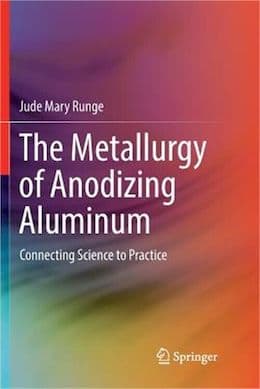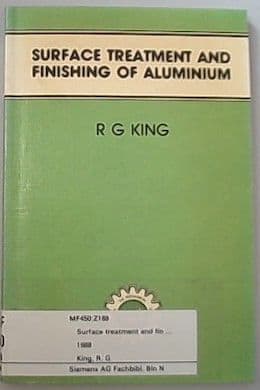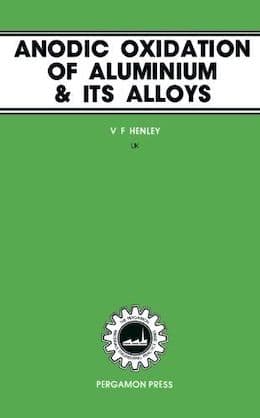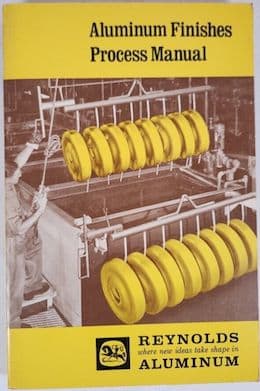
Curated with aloha by
Ted Mooney, P.E. RET

The authoritative public forum
for Metal Finishing 1989-2025

Thread 50/32
Determining Sulfuric Acid Percentage in Anodizing Tank
for Shops, Specifiers & Engineers

avail from eBay, AbeBooks, or Amazon

avail from eBay, AbeBooks, or Amazon

avail from eBay, AbeBooks, or Amazon

avail from eBay, AbeBooks, or Amazon

avail from eBay, AbeBooks or Amazon
(as an Amazon Associate & eBay Partner, we earn from qualifying purchases)
Q. My name is James White, I am working in the anodizing department of an aluminum company. I have been asking for quotes for differing equipment capable of providing real-time concentration readings of sulfuric acid to our anodizing operators. One response I received was a proposal for a piece of equipment that would measure aluminum sulphate concentration, from which the sulfuric acid concentration could then be estimated. Is this viable?
I understand that some sulfuric acid can be incorporated into the developed aluminum oxide, which would be unaccounted for with this method. However, I am not currently aware of any other reactions that would consume the sulfuric acid, other than the one I mentioned before that would produce the aluminum sulphate. I appreciate any feedback!
James White- Rialto California
November 4, 2021
publicly reply to James White
Ed. note: We're not really understanding the vendor's approach here. Hopefully they will recognize your name from their communications with you and chime in :-)
A. Hi James!
I'm curious what "real time" means to you and/or your vendor, and how automated you are, and whether your operators run in-tank ASF meters and check build during the run.
To me, real time means a near continuous monitoring that would be useful if you are fully automated, running the same parts configuration on repeat, with a dosing system (don't even get me started on this; I come from aquaculture and auto-titrators and dosers kill fish when they get a dirty probe or suffer a brief power outage).
If you're running manually with traditional process controls, manual titration at a frequency based upon a ratio of tank volume to parts throughput, measured in total surface area including racks, is adequate. If you want to get a bit more refined, I'd propose looking at a ratio of amp-hours on the rectifier clock to documented tank adds, and calculating what you might need for a really conservative drip feed from the drum, using a peristaltic pump set to ratio input acid based upon the rectifier being live, and still have your lab tech run manual titration for both aluminum and sulfuric acid on a schedule that meets spec (no offspec readings allowed, so schedule it to catch drift before control limits are breached).
Can you see I'm quite distrustful of autotitrators?
Humorous aside, a couple years ago a shop tried to poach me, I went in for a "tour" and found the autotitrator broken and leaking reagents all over the place, and they had not replaced their lab tech nor learned to test manually. Hence the poach. My dear current colleague, who had actually set up their heavy equipment when they built from scratch, confided that one of the reasons he peaced out was because of that stupid $140k robo-labrat never being as trustworthy as a real set of hands, and it actually made running the line almost impossible because it was always wrong lol. And then it was just broken, and no one knew what was in the tanks.
Guess they just could have asked us ;)
So, am I putting in a shameless plug for having someone in the Quality or Engineering or Technical Rodent Department test your tanks? Heck yes. Because I've seen what happens when a plating shop or Barramundi Fish Farm depends on a robot, and forgets to train a human to double check the results.
Sorry for the rant. Just please be circumspect when dealing with salesfolk. Some are now my friends for life, and some will just sell a dream ... of their own timeshare in Tampa.

Rachel Mackintosh
lab rat - Greenfield, Vermont
publicly reply to Rachel Mackintosh
⇩ Related postings, oldest first ⇩
Q. Just a quick question on figuring out the percentage of Sulfuric acid in my anodizing tank. I know that 165 gr/litre is equivalent to a 15% bath. If you do the math 165/15...you come up with 11. Can I use 11 as a factor when figuring out my percentage? i.e. a 12% bath would be 132 gr/liter? Thank you for any help.

Marc Green
anodizer - Boise, Idaho
2000
publicly reply to Marc Green
A. Marc,
If your solution 15% (weight/weight) corresponds to 165 g/l, it means that density is 1.1 g/cc (your 11, because to have g/l, you multiply also by 10), but a lower percentage as 12% has got for sure also a lower density due to the lower sulfuric acid content.
So you have to multiply % value by density (measured for instance weighing 100 cc of solution on a precise balance: if 100 are 108 g, the density is 1.08 g/cc).Don't forget that pure sulfuric (96-98%) has a density of 1.84 g/cc. Example: 12 * 1.08 * 10 = 129.6 g/l. I hope to read you again.

Francesco Cicchetti
- Sulmona, Italy
publicly reply to Francesco Cicchetti

Aluminum How-To
"Chromating - Anodizing - Hardcoating"
by Robert Probert
Also available in Spanish
You'll love this book. Finishing.com has sold almost a thousand copies without a single return request :-)
A. Sounds logical to me, but I'd take and obviously make up several different % baths and test your theory, but really, math is math, and that seems to be a logical way to start. How accurate it may be is questionable, but there is always a few % difference in this stuff anyway, just trust your instincts
Matthew Stiltner- Toledo, Ohio
2000
publicly reply to Matthew Stiltner
A. Marc:
I don't think the conversion factor holds true. My source is the Chemical Rubber Company Handbook of Chemistry and Physics 50th Edition, 1963 (I am an old guy!). 12 % is 129.6 g/l. At 20 %, it is 227.9 and at 30%, it is 365.6 g/l.
Your best bet is to purchase a CRC Handbook of Chemistry & Physics
[adv: on
Amazon &
AbeBooks &
eBay affil links]
or Lange's Handbook of Chemistry
[adv: on
Amazon,
AbeBooks, or
eBay affil links]
. It has a wealth of useful tables of specific gravity for most common solutions along with % stated in g/l and lbs/gal. Both books also give you invaluable information on reagent makeup for analytical work, conversion from metric to English units and a full section of mathematical expressions not easily found.
I have had my CRC since high school. I used it through my undergraduate work and all my working career. Chuck Reichert
- Seattle, Washington
2000
publicly reply to Charles R. Reichert CEF-SE
Q. I am dealing with hard anodising, I want have to calculate the concentration of sulfuric acid bath through quantitive analysis, so I want to know the detail procedure for this.
Aijazullah Tajir- Abu Dhabi, UAE
February 13, 2013
publicly reply to Aijazullah Tajir
A. You can use this formula to get a more exact answer for H2SO4 (g/l) Concentration as a function of Pwt(%)
Concentration(g/l) = Qf * SG(H2SO4) * D(H2O)
Qf = [330.9(Pwt^3)+92.3(Pwt^2)+572.6(Pwt)]/1000
where:
SG = 1.84 :Specific Gravity
D = 1000 g/l :Density
Qf= formula :Conversion Factor
Pwt = 0-1 : Percent Wt of H2SO4 12% = 0.12
----------------------------------------------
For Pwt = 12%
Qf= [330.9*.12^3 + 92.3*.12^2 + 572.6*.12]/1000
Qf= [70.6129]/1000 = 0.0706129
Concentration(g/l) = [0.0706129]*1.84 *1000 g/l
Con = 129.93 g/l
This is all derived from the basic formula:
Density(final) =
[Mass(H2SO4) + Mass(H2O)]/[Volume(H2SO4) + Volume(H2O)]
Solving for Final density as a function of SG & Pwt:
Df = D(H2O)/[(Pwt/SG)+(1+Pwt)]
Concentration(g/l) = Df*Pwt
I plugged this formula into Excel and did some
*math magic* to get a trend-line that gives the formula for Qf. (R^2 = 1)
Hopefully this will be useful to someone.
- Spotswood, New Jersey, USA
May 19, 2016
publicly reply to John Kent
Please see also --
• Topic 4408 "Dissolved Aluminum in Anodizing"
• Topic 5168 "Best Titration Method for sulfuric Acid"
• Topic 0287 "The Chemical Mechanism of Sulfuric Acid Anodizing"
Q, A, or Comment on THIS thread -or- Start a NEW Thread
